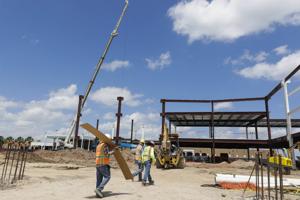The Brownsville South Padre Island International Airport should have its sleek new terminal building by the end of the fourth quarter of 2020, according to airport director Bryant Walker.
Airport ground traffic is being rerouted around what used to be the parking in front of the existing terminal and is now the spot from which the bones of the 91,000-square-foot, $43.8 million, electrochromic, glass-walled structure are rising.
The old terminal, built in the early 1970s and later expanded, is nonetheless cramped and obsolete, incapable of handling a sufficient number of passengers or aircraft, Walker said.
The project remains on budget and on schedule since breaking ground in December 2016, he said. All the pilings have been poured. Precipitation has been an issue for no more than 10 days, though rain days are built into the construction schedule, Walker said, adding that the contractor has requested no additional rain days so far. Other delays to date have been minor, he said.
“We did have some materials conditions,” Walker said. “We found some soft spots in the dirt when we were backfilling the foundation. We had to dig a little deeper than we were hoping to in order to fix that problem. You expect to run into things like that.”
Once the new terminal is open, the existing one will be demolished and its former footprint turned into ramp space for aircraft parking, though no demolition contract has been awarded yet, he said. Walker said the old terminal should be gone, all evidence of its existence erased and everything looking complete in the first quarter of 2021.
The $43.8 million is for the terminal building and “land-side” part of the project (as opposed to the air-side segment, between the new terminal and runways), he said. Construction of the terminal and land-side is being paid for through a combination of certificate-of-obligation bonds and Federal Aviation Administration funds.
The FAA is also paying for the air-side elements, including demolition of the old terminal. Walker estimated the air-side cost at around $8 million but said no firm figure is available yet. The jet bridges that will connect the terminal to aircraft will be paid for through Passenger Facility Charges, a fee that’s part of the cost of every plane ticket, he said.
“It’s a mechanism airports use for funding certain capital improvement projects,” Walker said.
Because bids for the terminal project came in higher than expected, some design features were left out of the original plan, he said. Contracts for some landscaping, for example, have yet to be awarded, Walker said. At the same time, the city is stepping up “to include some elements that would make more sense and be more cost effective to include now rather than later,” he said.
The city plans to install lighting along the airport entrance, for instance, Walker said.
“Being held so strictly to the budget, we were very good at designing a functional terminal,” he said. “It did not have elements that might be considered extraordinary or extravagant. Adding these elements in is not making it something extraordinary, but they’re things that are very nice to have. Lighting on the roadway is not required, but it’s a good thing to have.”
STEVE CLARK STAFF WRITER





